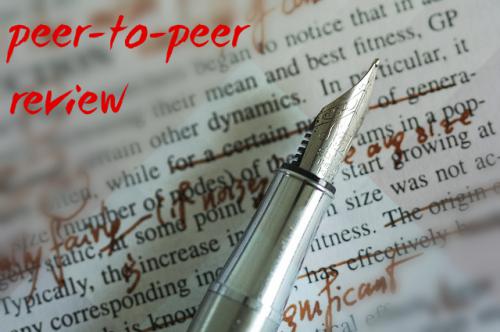You are here
Peer-to-Peer Review
Primary tabs

When revising a paper, a second pair of eyes is always useful. But who says those have to be human eyes? By utilizing a range of peer review technologies, your students get to play teacher for each other — and for themselves.
This plan lasts for multiple class periods and uses a number of different, though readily accessible, technologies. At different points, the students will need to: (1) Bring hardcopy versions of a paper they’ve written into class; (2) Have at-home access to virtual classroom technology like Canvas or Blackboard; (3) Have a set-up a personal account for a class-associated blog. While none of the particular lesson plans require classroom technology, students will need to have regular access to the Internet to fully participate.
There are a lot of reasons that peer review can be helpful, for students and for their instructor both, not least of which is the way that peer review can shift responsibility for stronger, sharper writing from a vertical and hierarchical model to a more horizontal and democratic one. This set of assignments allows students to not only participate in and benefit from peer review exercises, but begin to think critically about the value and process of social revision while increasing their skill set with digital technology. What follows are instructions for peer review for three different papers, which could be written back-to-back or spread across an entire semester. By no means do the papers need to be of any particular genre (research, advocacy, etc.) or any specific length or even have any particular relationship to one another; rather, what matters for the purposes of this plan is that the writing would benefit from peer review, whether that be in terms of grammar or rhetoric or what have you.
- The first peer review exercise is the most traditional: Students should bring in their finished papers the day the essays are due (or perhaps just before). In self-selected pairs or trios, students should pass the papers around, in the margins attempting to answer whatever specific goals the instructor might set, for brief face-to-face discussion at the end of class. These might include:
- Correcting any/all mechanical errors
- Summarizing the basic argument in 3–4 sentences
- Noting the strongest/weakest passage and articulating why it is so strong/weak
- In the second exercise, students will utilize the peer review functionality of some virtual classroom software — say, Canvas or Blackboard — to read through and comment on the papers of a couple of their classmates, this time grouped randomly. Such software offer a range of different markup tools, including line-by-line annotations and multicolor highlighters, that suggest a number of inventive possibilities: Perhaps all spelling errors can be highlighted blue and all run-ons red; or, if the students have completed a typical rhetorical analysis, whatever sections deal with pathos might be in green and those with ethos in yellow. The instructor might even encourage students to explore possibilities only afforded by digital technology, such as using reaction gifs at points in the marginalia.
- For the final exercise, students will upload an abbreviated version of their paper to a class-associated blog; once every essay is online, students will leave their feedback as comments on (at least two) individual posts. To maintain anonymity while still being able to tell who is who, you might want to allow students to use their initials in place of their actual names — or have a little more fun with it and allow students to create their own username. Leaving specific feedback will no doubt be more difficult at this stage, so the comments will likely be general if left to their own impulses, but for the purposes of experimentation students might be encouraged to devise their own way to note particularly jarring typos or specific points of interest.
Once the whole set of exercises have been explored, the class should discuss the benefits and failures of each type of technology, in effect reviewing their own peer reviewing: Which did they find easiest to use? Which was most helpful?
Aside from carefully considering and directly stating the peer review goals for each assignment, instructors should themselves be able to help students should they have any questions on how to use the technology — and trust me, they will. Hence it is useful to spend some time in class walking through the functionality of a virtual classroom or how to post a paper directly to a blog. As such, the instructor should have the blog as ready as possible well before the time those papers will be due, so that students have an idea of how their work will look online.
Peer review is most productive when students have explicit goals and questions to strive for and answer. What students should look for and comment on depends, of course, on the type of assignment and the person of the instructor; it might be interesting, however, if the same goals are set for each type of review, so that students have a fuller sense of how the differing technologies affect their ability to read and review, to comment and correct. They might note how the anonymity of a blog sometimes encourages less tactful criticism and fewer line edits — which raises the point that students, when doing peer review, should always be mindful of their classmates’ feelings and respectful of differing opinions or skill levels.
It can be somewhat of a headache to evaluate someone else ability to evaluate, so I would suggest grading on participation or including the peer review as part of a paper’s final grade.
This assignment was originally designed for a class on the rhetoric of the digital divide, and the various peer reviews were spread across an entire semester.
-

- Log in to post comments

